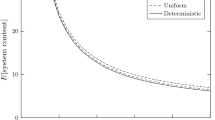Abstract
In this paper, we consider a practical queuing system with a finite number of input links and whose arrival process is correlated and consists of a train of a fixed number of fixed-length packets and a single server which is subjected to random interruptions. We model the server interruptions by a correlated Markovian on/off process with geometrically distributed on and off periods. We first derive an expression for the functional equation describing the transient evolution of this queuing system. This functional equation is then manipulated and transformed into a mathematical tractable form. This allows us to derive the probability generating function (pgf) of the system occupancy. From this pgf, closed-form expressions for various performance measures, such as mean and variance of system contents and customer delay can be derived. Finally, we illustrate our solution technique with some numerical examples, whereby we demonstrate the negative effect of correlation in the interruption process on the performance of the system. The paper presents new insights into the performance analysis of queuing systems with correlated arrivals and service interruption and it also covers some previously published results as a special case.
Similar content being viewed by others
References
Takagi, H. (1987). A survey of queuing analysis of polling models. In Proceedings of the third IFIP international conference on data communication systems and their performance, Rio de Janeiro, Brazil, 22–25, June 1987.
Takine, T., Sengupta, B., & Hasegawa, T. (1994). An analysis of a discrete-time queue for Broadband ISDN with priorities among traffic classes. IEEE Transactions on Communications, 42(2–4), 1837–1845.
Walraevens, J., Steyaert, B., & Bruneel, H. (2002). Delay characteristics in discrete-time GI-G-1 queues with non pre-emptive priority queuing discipline. Performance Evaluation, 50(1), 53–75.
Elloit, E. O. (1963). Estimates of error rates for codes on burst-noise channels. Bell System Technical Journal, 42, 1977–1997.
Van der Duyn Schouten, F. A., & Vanneste, S. G. (1995). Maintenance optimization of a production system with buffer capacity. European Journal of Operation Research, 82, 232–238.
Ibe, O. C., & Trivedi, K. S. (1990). Two Queues with alternating service and server breakdown. Queueing Systems, 7(3), 253–268.
Fiems, D., Steyaert, B., & Bruneel, H. (2004). Discrete-time queues with generally distributed service times and renewal-type server interruption. Performance Evaluation, 55, 277–298.
Doshi, B. (1986). Queueing systems with vacations—a survey. Queueing Systems, 1, 29–66.
Takagi, H. (1991). Queueing Analysis; A foundation of performance evaluation, volume 1: Vacation and priority systems, part 1. Amsterdam: Elsevier.
Takagi, H. (1993). Queueing Analysis; A foundation of performance evaluation, volume 3: Discrete-time systems. Amsterdam: Elsevier.
Hsu, J. (1974). Buffer behavior with Poisson arrival and geometric output processes. IEEE Transactions on Communications, 22, 1940–1941.
Heines, T. (1979). Buffer behavior in computer communication systems. IEEE Transactions on Communications, 28, 573–576.
Bruneel, H. (1986). A general treatment of discrete-time buffers with one randomly interrupted output line. European Journal of Operational Research, 27(1), 67–81.
Yang, O., & Mark, J. (1990). Performance analysis of integrated services on a single server system. Performance Evaluation, 11, 79–92.
Woodside, C., & Ho, E. (1987). Engineering calculation of overflow probabilities in buffers with Markov-interrupted service. IEEE Transactions on Communications, 35(12), 1272–1277.
Fiems, D., Steyaert, B., & Bruneel, H. (2003). Analysis of a discrete-time GI–G–1 queueing model subjected to bursty interruptions. Computers and Operations Research, 30, 139–153.
Fiems, D., Steyaert, B., & Bruneel, H. (2001). Performance evaluation of CAI and RAI transmission modes in a GI-G-1 queue. Computers and Operations Research, 28(13), 1299–1313.
Fiems, D., Steyaert, B., & Bruneel, H. (2004). Discrete-time queues with generally distributed service times and renewal-type server interruptions. Performance Evaluation, 55, 277–298.
Fiems, D. (2004). Analysis of discrete-time queuing systems with vacations. Ph.D. thesis, Department of Telecommunications and Information Processing, Ghent University, Belgium.
Pakes, A. G. (1974). On dams with Markovian inputs. Journal of Applied Probability, 10, 317–329.
Gopinath, B., & Morrison, J. A. (1988). Single server queues with correlated inputs. In Proceedings of the international symposium on complex performance modeling: measurement and evaluation, August 1978 (pp. 263–278).
Mehmet Ali, M., Zhang, X., & Hayes, J. F. (2003). A performance analysis of discrete-time queueing system with server interruption for modeling wireless ATM multiplexer. Performance Evaluation, 51, 1–31.
Kamoun, F. (2006). Performance analysis of a discrete-time queuing system with a correlated train arrival process. Performance Evaluation, 63(4–5), 315–340.
Xiong, Y., & Bruneel, H. (1992). Performance of statistical multiplexers with finite number of inputs and train arrivals. In Proceedings of INFOCOM (pp. 2036–2044).
Bruneel, H. (1993). Packet delay and queue length of statistical multiplexers with low-speed access lines. Computer Networks and ISDN Systems, 25, 1267–1277.
McKeown, N. (1997). A fast switched backplane for a gigabit switched router. Business Communications Review, 27(12).
Bruneel, H., & Kim, B. G. (1993). Discrete-time models for communication systems including ATM. Boston: Kluwer Academic.
Kamoun, F. (2006). The discrete-time queue with auto-regressive inputs revisited. Queuing Systems, 54, 185–192.
Kamoun, F. (2008). Performance analysis of a non-preemptive priority queuing system subjected to a correlated Markovian interruption process. Computers & Operations Research, 35(12), 3969–3988.
Author information
Authors and Affiliations
Corresponding author
Rights and permissions
About this article
Cite this article
Kamoun, F. Performance evaluation of a queuing system with correlated packet-trains and server interruption. Telecommun Syst 41, 267–277 (2009). https://doi.org/10.1007/s11235-009-9160-2
Published:
Issue Date:
DOI: https://doi.org/10.1007/s11235-009-9160-2




